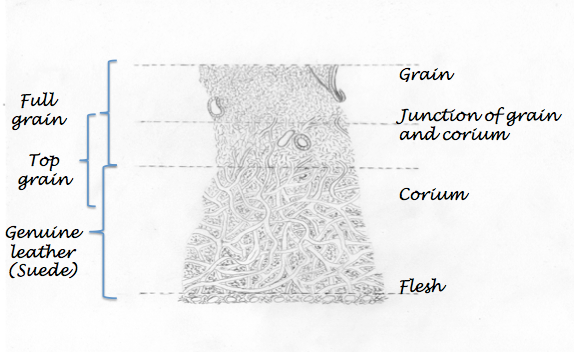About Leather
Ever wondered why your leather bag from last season is falling apart but your leather belt from ten years ago is holding up your jeans as well as the day you bought it? It may be the case that both items were labelled ‘real leather’ yet the difference in quality can be astounding. That’s because these items can actually be one of several types of leather of varying degrees of quality.
Nothing compares to the look, feel and smell of good leather and if done right, buying leather goods can be a real investment. The durability and versatility of leather means that it lasts well beyond the years of any other fabric, maybe even a lifetime. In this leather guide we will delve into the world of leather, identifying the four main types, their distinguishing features and the tanning processes used to treat them.

Leather 101:
Generally leather goods will fit into one of four categories: full grain, top grain, genuine or bonded. When we started Niche Lane, we didn't know what these terms meant and we figured that most people would be unsure about the terms too- so we thought we would share a little of what we have learned over the years with you so you can make a more informed choice. Here is a little about what these different labels mean:
Full Grain
Full grain leather refers to the top layer of the hide. Often considered to be the best quality leather, the fibre of full grain is unadulterated therefore strong and durable. The natural marks and imperfections in the leather make full grain distinguishable from the other types. Much like the scars and marks we accumulate on our own skin over a lifetime, bovine also acquires various nicks and marks on their skin during their days of grazing, being herded or jumping fences.
At Niche Lane, it was these unique characteristics in the leather's surface appearance which drew us to full grain buffalo leather: we see them as stories rather than flaws. That, combined with the incredible endurance of the leather means that the more you use the bag, the more charm and personality it gains.
Top grain
Top grain leather is considered to be the second highest grade and is also used for high-end leather products. Technically speaking, this type of leather is less expensive than full-grain as it has been ‘split’ from the top layer of the hide and is therefore thinner and more pliable. Unlike full grain leather, the surface of the top grain is sanded and finished with a top coat, giving it a more uniform look and perhaps a slighlty more "plastic' feel to you or me.
Genuine leather
Genuine leather is the third grade leather out of the four. This type of leather is commonly used for ‘suede’ products and is sourced from the layers of hide that are leftover from the ‘splitting’ process. The surface of the leather varies from smooth to rough, giving suede that distinctive look and feel. Products made of genuine leather are generally cheaper and don’t last very long.
Bonded leather
Bonded leather, also known as reconstituted leather, is composed of leftover scraps of leather that are shredded and bonded together on to a fibre sheet. If longevity and toughness are what you’re after, it’s best to avoid goods made of this type of ‘leather’.
Tanning Process
Since the dawn of man, humans have been transforming hides and skins into leather given its durable and versatile nature. Over the centuries, the tanning process has evolved and become more refined so that several different methods are now available:
Chrome-tanned leather
This process gets its name from the chromium sulphate and chromium salts used to the tame the raw hide. Its ability to create a more supple and pliable leather in a variety of exotic colours means that chrome-tanned leather makes up almost 80% of the global supply including that for Niche Lane.
Vegetable-tanned leather
As the name suggests, this process uses tannins from a variety of organic materials in order to create the leather. These organic materials can vary from tree bark, to leaves, to wood and fruits. What sets vegetable-tanned leather apart from other leathers is its changeability in water: hot water causes the leather to shrink and become rigid while cold water discolours the leather.
What is patina ?
Patina is a soft sheen that develops on the surface of leather over time. A marker of a well-loved product, the naturally occurring patina develops with time and age along with the scuffs and creases that add so much character to your leather bag. We often forget that leather is a natural product that absorbs the elements around it. Sunlight, natural oils, humidity and body lotions are all absorbed by the leather, darkening it in some places and subtly glazing it in others.
Our coffee colour leather is more susceptible to forming a patina than the tan coloured leather and this is down to the way the leather is processed. The drum-dyed finish of the tan leather means it is unlikely to gather a patina however the more raw, unprocessed coffee coloured leather is the perfect candidate for a beautifully developed patina.
